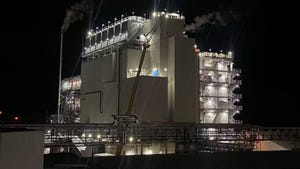Staying positive at Multivac
MPW’s Yvonne Kloepping recently visited packaging machinery manufacturer Multivac at its headquarters in Wolfertschwenden, Germany. The company’s thermoforming machines are built into form, fill and seal (FFS) packaging lines. Its user base principally is in the food, consumer goods and medical markets.
January 28, 2009
MPW’s Yvonne Kloepping recently visited packaging machinery manufacturer Multivac at its headquarters in Wolfertschwenden, Germany.
The company’s thermoforming machines are built into form, fill and seal (FFS) packaging lines. Its user base principally is in the food, consumer goods and medical markets.
Multivac employs about 2500, and manufactures more than 1100 thermoformers and traysealers as well as more than 3200 chamber (pouch sealing) machines a year. Yvonne spoke with Valeska Haux, the manufacturer’s director of corporate marketing, and Luc Van de Vel, director of the firm’s MCI business unit.
MPW: Multivac in November 2008 won its second major prize for machine technology in that year, the German Packaging Prize. The award recognized the ease operators have in cleaning your new machine. What sort of time saving will result for customers using these machines as they switch from one product to another?
Haux: Overall you could say that there is less downtime, and production time can be precisely calculated and optimized. How much time customers can save depends on the application, of course. But you could say about 20% time savings on average. The “cleaning-in-place” concept is much more relevant for foodstuffs than for medical.
MPW: Are there any recent material developments - plastic sheet materials - that have caught your attention? Are customers at all interested in PLA or other ‘bioplastics’? What about developments in barrier plastics for prevention of water absorption?
Haux: No, not lately. PLA acts just like polyester. It can be thermoformed just as well and seals perfectly on Multivac machines. However, PLA has no barrier function whatsoever. It absorbs water. So it is not an alternative for highly technical applications. The industry is not yet ready to develop a clean additive. So far, nobody has been able to produce a ‘clean’ (Ed.: referring to sustainable/bioplastic) barrier material. So PLA is not an alternative for medical or food because it has no barrier function.
MPW: Most machine manufacturers await a mediocre-to-poor year in 2009. What about Multivac?
Haux: For 2009 we expect to pretty much stay on the same level as in 2008. Since we are a global company, a recession in certain regions can be compensated for in others. Some of our goals for next year are to optimize and expand our retrofitting service and optimize delivery times for our customers.
The main issues of our customers will probably be the financing of new machines.
MPW: What keeps you and your company so positive? What is your advantage?
Haux: Our advantage right now is definitely the size of our company and the volume that we can produce and deliver. All our machines are customer-specific solutions. And we continuously offer innovative solutions that are constantly being further developed.
MPW: Energy savings have become a major issue for users, who of course need to reduce their operating costs. How has Multivac met this issue?
Haux: The two main energy wasters are thermoforming and sealing. We are working on making processes more energy efficient. An example would be lifting units - here it is better to move away from pneumatic and use electrical drives instead.
MPW: Where regionally do you see the strongest growth for machines that see use in the medical device market? Is medical device production shifting to Asia, as many have long forecasted?
Van de Vel: Asia, South America, Syria, Kuwait. Production for high-cost products is not really shifting to Asia. But production for low-cost products is. So there is definitely a shift, but if it is as big as everybody thought it would be is questionable. A boom market for medical devices right now is India.
MPW: Multivac presented the H 100 module with the two-axis HR 250 robot at the 2008 Interpack show. Is automation becoming an option that your customers want or need? What does automation add to the cost of a line? And is this sort of line most attractive to customers in high-wage areas, or do you foresee automation on thermoforming lines eventually becoming attractive to users regardless of local labor costs?
Van de Vel and Haux: Yes! Customers need automation. The simpler the processes are, the better. Costs end up being lower with a complete handling system. Automation is attractive for both high- and low-wage areas. The cost depends on the product. We can’t generalize that.
About the Author(s)
You May Also Like


